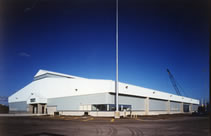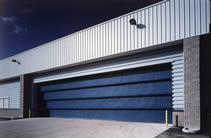ZRC Cold Galvanizing Compound has been specified and applied as a substitute for hot-dip galvanizing on two 20 x 40' steel doors at the Tampa Port Authority Transit Shed, Tampa Bay, Florida. ZRC effectively solved the problem of providing long-term protection for the large doors in a corrosive atmosphere, while allowing the contractor to apply zinc protection to pre-manufactured doors at the job site. This resulted in a level of corrosion resistance which matches hot-dip galvanizing.
Galvanic Protection in a Corrosive Atmosphere
The Tampa Port Authority Transit Shed is located just 100 ft. from Tampa Bay in a semi-tropical environment. It is an 86,000 sq. ft. structure which was completed in early December of 1991. Since it is a "transit" shed which is used for short-term storage of industrial and construction materials, paper and equipment, there is heavy in-going and out-going traffic at all times. Goods are brought in by ship and then transported by fork lift or truck to the transit shed. Large trucks are going through the electrically-operated, steel, vertical lift doors constantly.
Operated by a wholly-owned subsidiary of the Tampa Port Authority, a quasi-public agency, the shed is designed to handle large volume in one of the country's busiest ports. The engineering firm managing the project was the DSA Group, a 100-person, multi-discipline firm headquartered in Tampa. The architectural design was by James L. Smith & Associates, and the contractor was the Williams Company, both of Tampa. The steel doors were manufactured by Electric Power Door of Hibbing, MN.
The Best Alternative to Hot-Dip Galvanizing
Sofia Rovira, principal and executive vice president of DSA and director of DSA's Building Design Services group, says her firm accepted ZRC Cold Galvanizing Compound as the best possible substitute for hot-dip galvanizing on the pre-manufactured transit shed doors. "Based on the information we have from the contractor, ZRC will provide the same lifespan as hot-dip galvanizing. It was the only acceptable process in place of hot-dip galvanizing." The doors carry a warranty which guarantees them to be free of rust perforation for 5 years.
In order to prepare the surface of the doors, they were sandblasted to SSPC-SP-6 (Commercial Blast). ZRC was applied by conventional air spray. Two coats of epoxy were then applied as a topcoat.
"Another important factor in specifying ZRC," says Rovira "is its true cathodic action. With the volume of heavy traffic passing through the transit shed doors, it is likely they will be scratched. ZRC should provide zinc protection even when the doors are scratched to bare metal."
Rovira concluded: "The main advantage of ZRC was that it allowed us to provide galvanized protection on site-without delays to the project."



